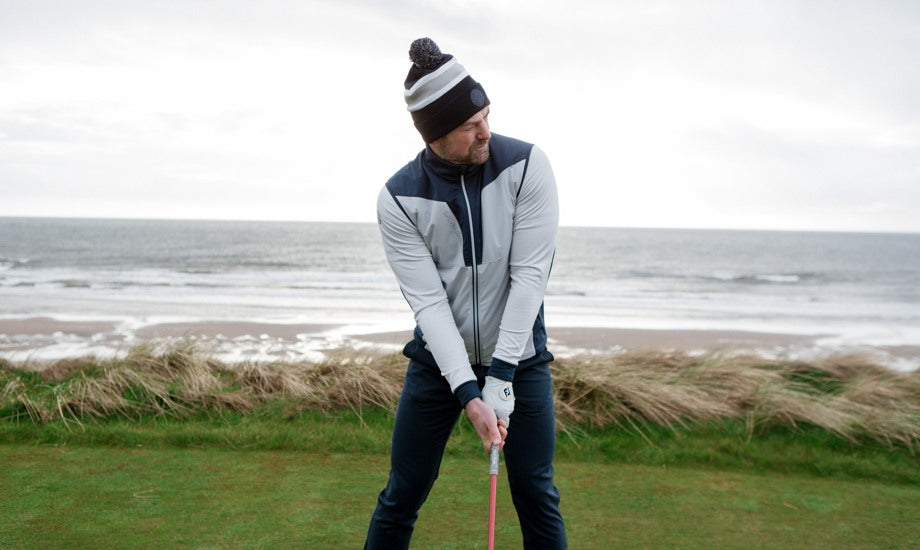Windy Golf Guide: How to Play Golf in the Wind
Golf can be a difficult game, even in benign weather conditions. But when you add some wind to the equation, it’s no surprise that scores tend to go up significantly.
There are two main reasons for this. The first is that higher-handicap amateurs aren’t familiar with the basic aerodynamics of a golf ball in flight and how a golf ball behaves in windy conditions. That lack of familiarity then leads to the second reason, which is not being aware of the specific stance and swing changes that are needed to counteract those wind-caused ball flight issues.
In this article, I’ll discuss both of those things: I’ll briefly describe the basic aerodynamic principles of what happens to a golf ball after impact and how those forces affect how it will fly through the air. And I’ll then provide some swing-change suggestions that will help you to be a more effective player in windy conditions.
And lastly, I’ve put together some useful data that will guide you in ascertaining exactly how much a particular wind (whether a headwind or a tailwind) will affect the distance your golf ball will actually fly, rather than relying on guesswork to attempt to determine that. This will make club selection a lot easier for you and will make your results far more reliable.

Basic Aerodynamics of Golf Ball Flight
When a golf club face contacts the ball, there is a significant amount of ball compression that occurs. It can’t be seen with the naked eye, but slow-motion video cameras have captured the amazing extent to which a golf ball is “squished” at impact. After being compressed in this manner, the ball then rebounds and leaves the club at a high rate of speed.
This dramatic compression, in conjunction with the friction that occurs between the ball and the clubface, causes the ball to take flight with a significant amount of backspin. The amount of backspin varies depending on the loft of the club that was used (obviously, a pitching wedge imparts more spin than a 7-iron, etc.) as well as on the speed of your swing. The faster you swing, the more that spin rate increases.
Spin Creates Lift
Once the ball starts to travel through the air, the spin that was imparted at impact creates “lift” that causes the ball to climb into the sky, like air under the wings of a plane. Under normal weather conditions, this “lift” is a desirable thing and is actually vital to generating distance. It is what keeps the ball in the air. In fact, without lift, the ball would fall from the sky after a short flight, and golfers would be understandably disappointed with the results.
However (and here’s the important part as far as this article’s topic is concerned), when hitting golf shots in windy conditions, that lift that normally helps you to create carry distance in calm weather actually becomes a liability. We’ve all seen it. Our shots that we hit into a headwind “balloon” much higher than normal, and travel far shorter than normal as a result. Why do golf balls balloon as the wind increases? Well, remember what causes lift: spin and ball speed.
So, by now you should be able to start connecting the dots. If spin and ball speed are problematic when hitting into a wind, the proper strategy to counteract the wind would be to create less spin and less ball speed. Less spin and less speed will create less lift and will result in a lower trajectory where the ball flies under the wind and will be less prone to the ballooning effect that is causing your current wind shots to come up short.
“When It’s Breezy, Swing Easy”
You may have heard this age-old saying before, and now you can see why it’s accurate and why it’s good advice. It explains succinctly what your approach should be when playing in windy conditions.
In short, the best strategy when hitting into a strong headwind is to take more club than you normally would, but to swing at a more deliberate, unhurried pace.
This is counter-intuitive to most amateur golfers who, when hitting into a strong wind, simply resort to swinging harder in an ill-advised effort to overpower the wind. Hopefully you now see that this is the opposite of what is actually required. Swinging harder creates more spin, which in turn creates a higher, ballooning ball flight due to the effects of lift.

Changes to Make to Hit Better Shots in the Wind
Now that you understand some of the basic aerodynamics of ball flight, it should be easier to see why certain stance and swing adjustments are needed to be able to control your ball in these challenging conditions. The following modifications should be implemented when playing in the wind:
- Club Selection: Choose clubs with less loft when hitting into a headwind because they will produce a lower ball flight.
- Choke Down on the Club: Gripping down on the club will give you better control, an essential requirement when hitting in windy conditions.
- Ball Position: Play the ball slightly back in your stance. This will also promote a lower ball flight and reduce the chance of the wind affecting the trajectory of your shot.
- Widen Your Stance: A wider stance will lower your center of gravity. This makes your swing shorter and therefore affords better shot control.
- Swing Smoothly: Avoid trying to overpower the shot. Instead, focus on making a smooth, controlled swing. Swinging harder can result in an erratic ball flight and higher-than-desired trajectories due to the increased spin rate.
- Stay Patient: Windy conditions can be challenging for even the best golfers. Stay patient and execute your shots using these recommended changes but accept the fact that you may need to adjust your expectations for scoring on windy days.
- Practice in the Wind: The best way to improve your wind play is to practice in windy conditions. Head to the driving range on a windy day and work on controlling your ball flight and trajectory.

How Much Does Wind Actually Impact Shot Distances?
Every golfer knows that wind can play havoc with a golf ball in the air. Shots hit into a headwind, and even shots hit downwind, have effective yardages that are different than the actual yardages.
As an example, if you’re hitting a 150-yard shot into a strong headwind, you wouldn’t be advised to select the same iron that you would use to hit a 150-yard shot on a calm day. You need to determine how much the wind will affect your upcoming shot and mentally add that amount of yardage to your shot (i.e., choosing a club that normally carries, say, 170 yards, knowing that the wind will knock about 20 yards off that distance).
But, at best, making club selections this way is nothing more than guesswork. Wouldn’t it be good to have a more “scientific” method of determining what the effective yardage is on shots hit into, and with, the wind?
Well, below I’m providing you with that more scientific approach to your distance calculations. As you’ll see, the primary factor is knowing the actual miles-per-hour of the wind. Armed with that information, just follow the table to see how much distance to either add or subtract from the actual yardage to identify the effective yardage. Since most of us are not able to estimate wind speed on our own, it would probably be a good idea to check a reliable local weather app on your smartphone to verify what the speed of the wind is that day.
Two Methods to Calculate Effective Yardages in the Wind
As a general rule of thumb, you can use the following formulas when calculating the approximate distance adjustments you need to make when hitting in windy conditions, depending on whether you are hitting into or with the wind:
- When hitting into a headwind: The miles-per-hour of the wind should equal the number of yards you should add to the shot (e.g., with a 10-mph headwind, add an extra 10 yards to the measured distance).
- When hitting with a tailwind: Take half the miles-per-hour of the wind and subtract that from the distance of the shot (e.g., with a 10 mph tailwind, subtract 5 yards from the measured distance to your target).
An alternate way to estimate the needed distance adjustment would be to add 1% for every 1 mph of headwind, or to subtract .5% for every 1 mph of tailwind. Using this formula, I’ve put together a table that illustrates how various wind speeds (5 mph, 10 mph, 20 mph, and 30 mph) will affect your distance calculation when playing from three different yardages (100 yds., 150 yds., and 200 yds. from your target):
| Actual Distance to Target | Headwind | Tailwind | ||
|---|---|---|---|---|
| Headwind Speed | Effective Distance | Tailwind Speed | Effective Distance | |
| 100 yds. 91 metres |
5 mph / 8 km/h | 105 yds / 96 m | 5 mph / 8 km | 98 yds / 90 m |
| 10 mph / 16 km/h | 110 yds / 101 m | 10 mph / 16 km/h | 95 yds / 87 m | |
| 20 mph / 32 km/h | 120 yds / 110 m | 20 mph / 32 km/h | 90 yds / 82 m | |
| 30 mph / 48 km/h | 130 yds / 119 m | 30 mph / 48 km/h | 85 yds / 78 m | |
| 150 yds. 137 metres |
5 mph / 8 km | 158 yds / 144 m | 5 mph / 8 km | 146 yds / 133 m |
| 10 mph / 16 km/h | 165 yds / 151 m | 10 mph / 16 km/h | 142 yds / 130 m | |
| 20 mph / 32 km/h | 180 yds / 165 m | 20 mph / 32 km/h | 135 yds / 123 m | |
| 30 mph / 48 km/h | 195 yds / 178 m | 30 mph / 48 km/h | 127 yds / 116 m | |
| 200 yds. 183 metres |
5 mph / 8 km | 210 yds / 192 m | 5 mph / 8 km | 195 yds / 178 m |
| 10 mph / 16 km/h | 220 yds / 201 m | 10 mph / 16 km/h | 180 yds / 165 m | |
| 20 mph / 32 km/h | 240 yds / 219 m | 20 mph / 32 km/h | 180 yds / 165 m | |
| 30 mph / 48 km/h | 260 yds / 238 m | 30 mph / 48 km/h | 170 yds / 155 m | |

Final Thoughts
Playing golf in the wind is challenging for everyone, even the pros. But if you use the information in this article about ball flight aerodynamics and stance/swing modifications, you’ll find that your performance will improve dramatically. Above all, when hitting into a strong headwind, remember that controlling the height of the shot is the #1 priority.
Jack Nicklaus once provided some valuable insight about this that should confirm to everyone the importance of ball flight control in the wind. Many years ago, he was interviewed during a practice round in heavy wind conditions. He was about to hit his approach shot and said the following: “I’m sitting here at 180 yards from the hole. Most people will try to take a 5-iron. Quite often, I’ll go down to a 3-iron or even a 2-iron. Choke it down to make it 7-iron length with a 3-iron loft, then I’m going to get about a 5-iron distance.”
Although none of us will ever have the skill and feel that Nicklaus had in his prime, we can all start incorporating this kind of strategic thinking as we prepare to hit shots in heavy winds.
Embrace the challenge the next time you face windy conditions and use these strategies and swing tips as you prepare for each shot. You’ll be surprised at how much better you’ll score.
- Bill Sullivan






